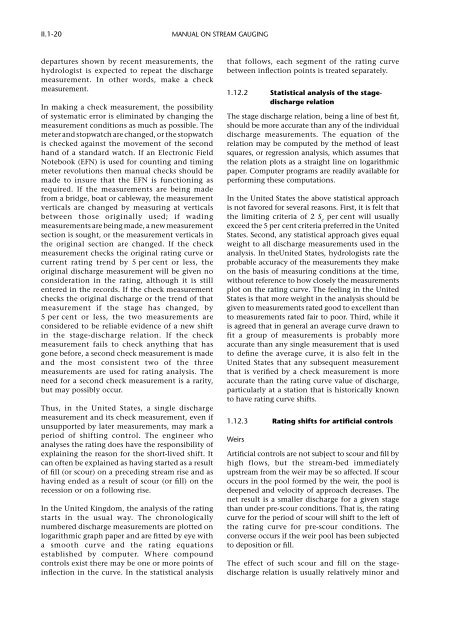MANUAL ON STREAM GAUGING - E-Library - WMO
MANUAL ON STREAM GAUGING - E-Library - WMO
MANUAL ON STREAM GAUGING - E-Library - WMO
- No tags were found...
You also want an ePaper? Increase the reach of your titles
YUMPU automatically turns print PDFs into web optimized ePapers that Google loves.
II.1-20manual on stream gaugingdepartures shown by recent measurements, thehydrologist is expected to repeat the dischargemeasurement. In other words, make a checkmeasurement.In making a check measurement, the possibilityof systematic error is eliminated by changing themeasurement conditions as much as possible. Themeter and stopwatch are changed, or the stopwatchis checked against the movement of the secondhand of a standard watch. If an Electronic FieldNotebook (EFN) is used for counting and timingmeter revolutions then manual checks should bemade to insure that the EFN is functioning asrequired. If the measurements are being madefrom a bridge, boat or cableway, the measurementverticals are changed by measuring at verticalsbetween those originally used; if wadingmeasurements are being made, a new measurementsection is sought, or the measurement verticals inthe original section are changed. If the checkmeasurement checks the original rating curve orcurrent rating trend by 5 per cent or less, theoriginal discharge measurement will be given noconsideration in the rating, although it is stillentered in the records. If the check measurementchecks the original discharge or the trend of thatmeasurement if the stage has changed, by5 per cent or less, the two measurements areconsidered to be reliable evidence of a new shiftin the stage-discharge relation. If the checkmeasurement fails to check anything that hasgone before, a second check measurement is madeand the most consistent two of the threemeasurements are used for rating analysis. Theneed for a second check measurement is a rarity,but may possibly occur.Thus, in the United States, a single dischargemeasurement and its check measurement, even ifunsupported by later measurements, may mark aperiod of shifting control. The engineer whoanalyses the rating does have the responsibility ofexplaining the reason for the short-lived shift. Itcan often be explained as having started as a resultof fill (or scour) on a preceding stream rise and ashaving ended as a result of scour (or fill) on therecession or on a following rise.In the United Kingdom, the analysis of the ratingstarts in the usual way. The chronologicallynumbered discharge measurements are plotted onlogarithmic graph paper and are fitted by eye witha smooth curve and the rating equationsestablished by computer. Where compoundcontrols exist there may be one or more points ofinflection in the curve. In the statistical analysisthat follows, each segment of the rating curvebetween inflection points is treated separately.1.12.2 Statistical analysis of the stagedischargerelationThe stage discharge relation, being a line of best fit,should be more accurate than any of the individualdischarge measurements. The equation of therelation may be computed by the method of leastsquares, or regression analysis, which assumes thatthe relation plots as a straight line on logarithmicpaper. Computer programs are readily available forperforming these computations.In the United States the above statistical approachis not favored for several reasons. First, it is felt thatthe limiting criteria of 2 S eper cent will usuallyexceed the 5 per cent criteria preferred in the UnitedStates. Second, any statistical approach gives equalweight to all discharge measurements used in theanalysis. In theUnited States, hydrologists rate theprobable accuracy of the measurements they makeon the basis of measuring conditions at the time,without reference to how closely the measurementsplot on the rating curve. The feeling in the UnitedStates is that more weight in the analysis should begiven to measurements rated good to excellent thanto measurements rated fair to poor. Third, while itis agreed that in general an average curve drawn tofit a group of measurements is probably moreaccurate than any single measurement that is usedto define the average curve, it is also felt in theUnited States that any subsequent measurementthat is verified by a check measurement is moreaccurate than the rating curve value of discharge,particularly at a station that is historically knownto have rating curve shifts.1.12.3 Rating shifts for artificial controlsWeirsArtificial controls are not subject to scour and fill byhigh flows, but the stream-bed immediatelyupstream from the weir may be so affected. If scouroccurs in the pool formed by the weir, the pool isdeepened and velocity of approach decreases. Thenet result is a smaller discharge for a given stagethan under pre-scour conditions. That is, the ratingcurve for the period of scour will shift to the left ofthe rating curve for pre-scour conditions. Theconverse occurs if the weir pool has been subjectedto deposition or fill.The effect of such scour and fill on the stagedischargerelation is usually relatively minor and
















